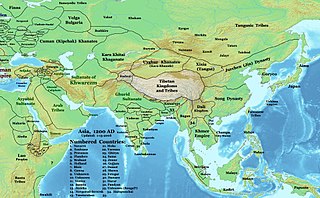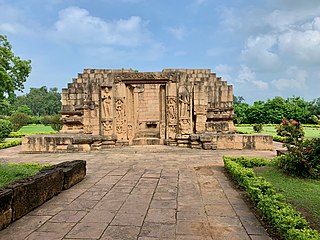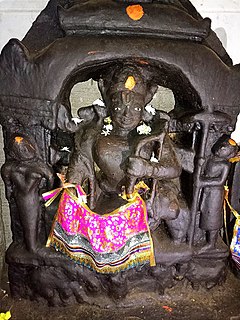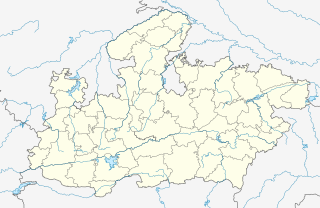
Chandragupta II, also known by his title Vikramaditya, was one of the most powerful emperors of the Gupta Empire in northern India.

The Chandelas of Jejakabhukti were a dynasty in Central India. They ruled much of the Bundelkhand region between the 9th and the 13th centuries.

Dakshina Kosala is a historical region of central India. It was located in what is now Chhattisgarh and western part of Odisha. At its greatest extent, it may have also included a part of the Vidarbha region in present-day Maharashtra.

Malhar is a small town situated in Bilaspur district of Chhattisgarh, India. A historically important site that once was a major city and served as a capital in the 1st millennium, it has been referred to as Mallar, Mallari and Sarabhapur in inscriptions and Indian literature. In contemporary times, it is more village like with mounds and ruins of an ancient fort, two restored Shiva temples and a museum with the ruins of major group of Hindu, Jain and Buddhist temples. It has archaeological significance. It is about 30 kilometers southeast from Bilaspur in a rural terrain, connected with a feeder road from India's National Highway 49.

The Eastern Ganga dynasty also known as Rudhi Gangas or Prachya Gangas were a large medieval era Indian royal dynasty that reigned from Kalinga from as early as the 5th century to the early 15th century. The territory ruled by the dynasty consisted of the whole of the modern-day Indian state of Odisha as well as major parts of West Bengal, Andhra Pradesh and Chhattisgarh. The early rulers of the dynasty ruled from Dantapuram; the capital was later moved to Kalinganagara, and ultimately to Kataka . Today, they are most remembered as the builders of the world renowned Puri Jagannath Temple and Konark Sun Temple, a UNESCO World Heritage Site at Konark, Odisha.

Gangesvara Anantavarman Chodaganga Deva was a ruler of the Eastern Ganga dynasty which ruled the southern part of Kalinga, India. He was the son of Rajaraja Deva and Rajasundari, the daughter of emperor Virarajendra Chola. The Chola king Kulothunga Chola I of the Chola dynasty was his uncle. However, historian S.N. Sen states that Anantavarman was the maternal grandson of Kulottunga I. The Jagannath Temple at Puri was rebuilt in the 11th century atop its ruins by Anantavarman Chodaganga.
The Kalachuris of Tripuri, also known the Kalachuris of Chedi, ruled parts of central India during 7th to 13th centuries. Their core territory included the historical Chedi region, and their capital was located at Tripuri.
Sallakshana-Varman was a king of the Chandela dynasty of India. He succeeded his father Kirttivarman as the ruler of the Jejakabhukti region. The inscriptions of his descendants suggest that he achieved military successes against the Paramaras, the Kalachuris of Tripuri and the ruler of Kanyakubja.
The Kalachuris of Ratnapura were a central Indian dynasty during 11th and 12th centuries. They ruled parts of present-day Chhattisgarh from their capital at Ratnapura. They were an offshoot of the Kalachuris of Tripuri, and ruled as vassals of the parent dynasty for many years.
The Kalachuris also known as Kalachuris of Mahishmati were an Indian dynasty that ruled in west-central India between 6th and 7th centuries. They are also known as the Haihayas or as the "early Kalachuris" to distinguish them from their later namesakes.
The Yajvapala dynasty ruled parts of central India during the 13th century CE. Their capital was located at Nalapura. They are also known as Jajapella or Jajpella. The Yajvapalas carved out a kingdom in northern Madhya Pradesh during the first half of the 13th century, and successfully resisted invasions by the Chandelas and the Delhi Sultanate over the next few decades. It is not certain how their rule ended, but they probably fell to the Delhi Sultanate by the end of the century.
The Uchchhakalpa dynasty ruled parts of central India during 5th and 6th centuries. Their territory included north-eastern parts of present-day Madhya Pradesh. Their capital was located at Uchchhakalpa, the present-day Unchehara.
Yuvarajadeva II was a ruler of the Kalachuri dynasty of Tripuri in central India. His kingdom was centered around the Chedi or Dahala region in present-day Madhya Pradesh. He established matrimonial relations with the Chalukyas of Kalyani, and was defeated by their rival, the Paramara king Munja.
Gangeyadeva was a ruler of the Kalachuri dynasty of Tripuri in central India. His kingdom was centered around the Chedi or Dahala region in present-day Madhya Pradesh.
Lakshmikarna, also known as Karna, was a ruler of the Kalachuri dynasty of Tripuri in central India. His kingdom was centered around the Chedi or Dahala region in present-day Madhya Pradesh.
Gayakarna was a ruler of the Kalachuri dynasty of Tripuri in central India. His kingdom was centered around the Chedi or Dahala region in present-day Madhya Pradesh.
Jayasimha was a ruler of the Kalachuri dynasty of Tripuri in central India. His kingdom was centered around the Chedi or Dahala region in present-day Madhya Pradesh. He unsuccessfully tried to assert his authority over the Kalachuris of Ratnapura, and seems to have suffered a defeat against the Chandelas.
Vijayasimha was a ruler of the Kalachuri dynasty of Tripuri in central India. His kingdom was centered around the Chedi or Dahala region in present-day Madhya Pradesh.

Tewar is a village in the Jabalpur district of Madhya Pradesh, India. It is the site of Tripuri, an ancient city-state, and the capital of the later Kalachuris during the 8th–13th centuries.
Prithvi-deva II was one of the most powerful Ratnapura Kalachuri kings, who ruled over the present-day Indian state of Chhattisgarh. His reign is placed 1135-1165 CE.







